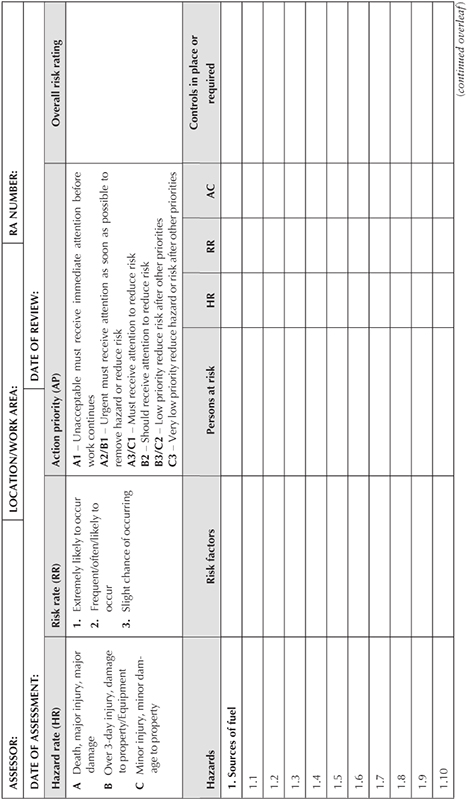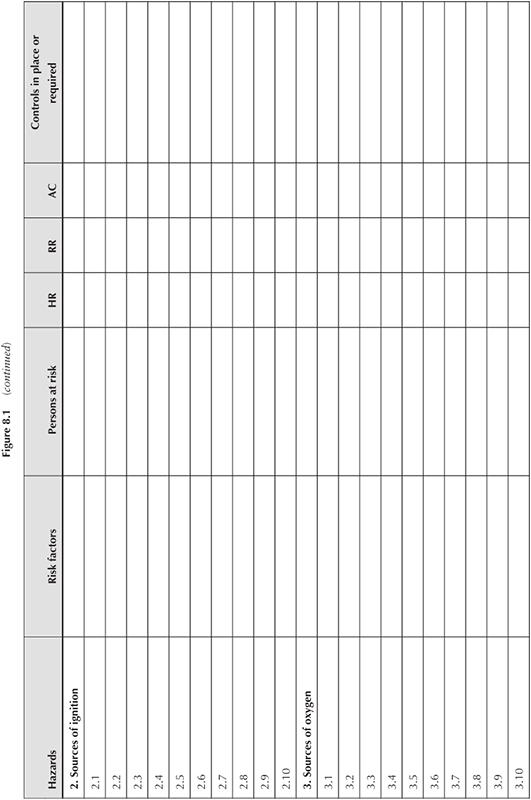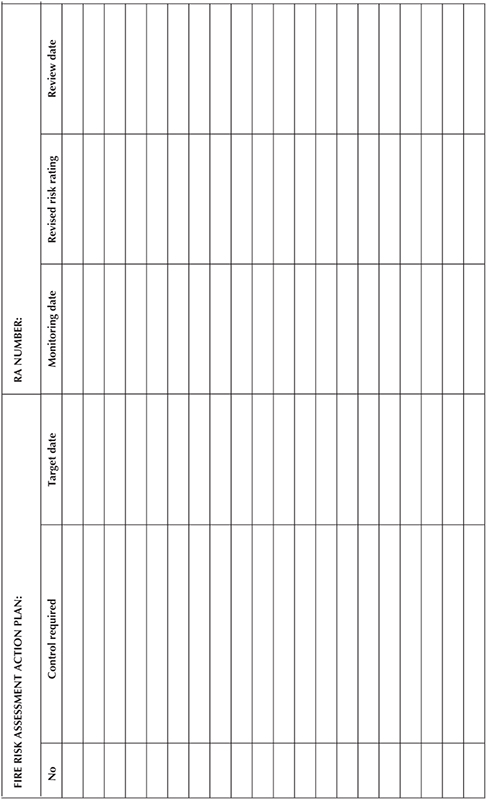8
Fire Safety and Emergencies
The consequences of fire and other emergencies can have a devastating physical and psychological effect on those who are directly involved. In addition, it can also have an impact on their immediate family as a result of human suffering and financial loss. The consequences not only affect people but also seriously disrupt business operation and, in the most severe cases, can lead to business failure. Being prepared for emergencies is a vital part of health and safety management as it helps to prioritise emergencies and put preventive and protective measures in place. This chapter will provide, in detail, specific fire safety measures; however, the principles should be applied to all types of emergency situations.
- Health and Safety at Work etc. Act 1974:
Employers have a general duty to ensure, so far as is reasonably practicable, the health, safety and welfare of employees and others. This includes protecting people from fire and other foreseeable risks.
- Regulatory Reform (Fire Safety) Order 2005 (RRFSO):
The Employer or ‘responsible person’ must take ‘general fire precautions’ and carry out other fire safety duties that are required to protect ‘relevant persons’ in the case of fire.
- Management of Health and Safety at Work Regulations 1999:
Employers must make suitable and sufficient assessment of health and safety risks, including risks from fire. Employers who share workplaces are required to co-operate with other people and co-ordinate any fire safety measures.
- Health and Safety (Signs and Signals) Regulations 1996:
Employers (Occupiers) have a duty to provide fire safety signs where risks cannot be eliminated or suitably controlled by any other means. Signs must contain both text and pictogram and employees must be trained so they are familiar with the instruction.
- Building Regulations 2000:
Persons planning and co-ordinating new buildings or significant alterations to existing buildings must take fire safety into consideration. In particular, the structure, means of warning and escape, internal & external fire spread, and facilities for disabled people and the fire service.
An emergency can happen at any time; therefore, it is important to identify what type of emergency may occur in the practice. The following list provides a range to consider:
- Accidents
- Medical emergency
- Threats to personal safety
- Power failure
- Gas leak
- Storm
- Flood
- Sabotage
- Bomb threat
- Pressure vessel explosion
- Mercury spillage and other chemical escape
- Construction work
- Asbestos
- Radiation
- Fire
Everyone should be involved in identifying emergencies within the practice. This helps to facilitate the development of an emergency plan, which is both relevant and appropriate to the individual circumstances and situations.
Emergencies will require an urgent and immediate response in order to minimise the consequences. Emergency procedures should be planned and well thought out so individuals can respond quickly without having to rely on information from managers or supervisors. The emergency plan and associated procedures should be documented, communicated and practised to ensure that it is fully understood and appropriate to the working environment. When developing the plan, the following generic factors should be considered:
- Action to be taken by the person discovering the emergency
- Special responsibilities for people such as calling the emergency services, shutting down the power or coordinating the emergency
- Responsibilities of all other persons
- Warning systems and locations of fire extinguishers or isolating switches
- Evacuation procedures
- Location of escape routes and exits and assembly (muster) points
- Arrangements for evacuating vulnerable people, for example, disabled persons
- Arrangements for equipment to deal with the emergency, for example, fire extinguishers
- Procedures for meeting and cooperating with emergency services
- Information, instruction and training arrangements to implement the plan, taking into consideration the needs of employees, visitors, contractors and patients
The emergency plan should state when a situation is to be classed as an emergency and how the emergency procedure is to be implemented. It must also emphasise that no one should put themselves at risk and that the aim is to ensure, so far as is reasonable, everyone’s safety.
Legal Definitions
Throughout the RRFSO certain terms are used, which directly relate to the legal duties imposed.
Responsible person
- The employer if any of the workplace is under his control, or
- The person who has control of the premises in connection with carrying out the business function (occupier)
- The owner, where the person in control of the premises does not have control of the business function
Relevant person
- Any person who is or may be lawfully on the premises, such as employees or patients
- Any person in the immediate vicinity who may be at risk
The responsible person is not expected to carry out fire safety duties in respect of fire fighters as he/she cannot be expected to know how he/she will operate in the event of fire. Therefore, fire fighters are not classed as ‘relevant persons’.
The ‘responsible person’ is required to ensure the safety of employees and anyone else who is a relevant person; the following measures must be taken:
- Observe general fire precautions – measures that
- reduce the risk of fire and fire spread;
- are in relation to the means of escape;
- ensure the means of escape can be safely and effectively used at all times;
- are in relation to fire fighting;
- are in relation to fire detection and warning;
- are in relation to emergency action including information, instruction and training and alleviating the effects of fire.
- Carry out suitable and sufficient assessment of fire risks.
- Apply principles of prevention that emphasise risk avoidance and, if not possible, risk evaluation.
- Make arrangements for managing fire safety to include the measures for planning, organisation, control, monitoring and reviewing of the preventive and protective measures.
- Eliminate risks from dangerous substances by substituting them for substances that are less dangerous. In the event of an accident related to a dangerous substance make additional emergency measures available.
- Provide fire fighting equipment, for example, extinguishers, fire blankets or sprinklers. In addition, provide means of fire detection equipment and fire alarms appropriate to the needs of the premises and ensure this is maintained in efficient working order by a competent person.
- Ensure that fire resistance fabrications in walls and doors are kept in good order and fire doors have appropriate seals and strips and closing devices.
- Provide a means of escape that leads to a place of safety, in particular, doors that open easily and in the direction of escape. They should be sufficient in number, be suitably signed giving clear instruction; emergency lighting should be provided where necessary.
- Have consideration for vulnerable groups who may need special measures in the event of fire – for example, disabled people, expectant mothers and young persons.
- Have an emergency plan and associated procedures in place in the event of serious and imminent danger (see emergency plan above).
- Appoint a competent person or persons (from within the organisation where possible) to assist the responsible person in meeting his/her duties and implementing fire safety measures. A competent person must have sufficient knowledge, skills and abilities to carry out his/her duties.
- Provide relevant information to employees and anyone working in the premises on the fire safety measures adopted by the organisation.
- Adequate safety training should be provided to employees when they commence employment and when anything changes, and routine refresher training should also be provided. Training must include regular fire drills and must take place during working hours.
- Where responsible people share buildings they must communicate and coordinate fire safety measures and cooperate with each other.
The above-mentioned duties relate to all workplaces; however, dental settings may not present the same level of risk as larger organisations or more complex occupations.
Employees’ Duties
Employees also have a duty to comply with legislation, which includes the following:
- To take reasonable care for themselves and other relevant persons
- To cooperate with their employer
- To report any shortcomings in the fire safety measures
Before undertaking a fire risk assessment it is suggested to read Chapter 19, which provides definitions of key terms and a simple risk rating evaluation (Figure 8.1). The purpose of a fire risk assessment is to help identify the preventive and protective measures that are required in order to comply with legislation, and also to consider the safety of premises and ensure the safety of people. Risk assessments identify how fire may start and what needs to be done to remove or reduce the risk of fire occurring and if fire does break out, how to control the spread of fire in order to contain it quickly and effectively and what fire protection is required. Risk assessments form the basis of prevention and protection and are an absolute must in order to meet the requirements of the RRFSO, and subsequently put controls in place to protect people. The fire risk assessment process should be carried out in the following stages:
Figure 8.1 Fire risk assessment record and action plan.


Stay updated, free dental videos. Join our Telegram channel

VIDEdental - Online dental courses



